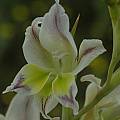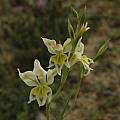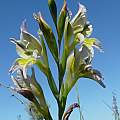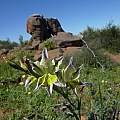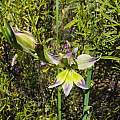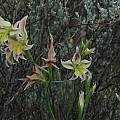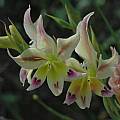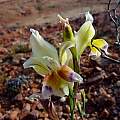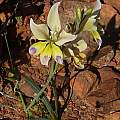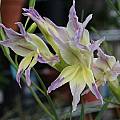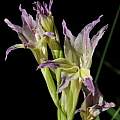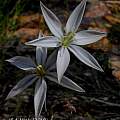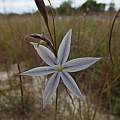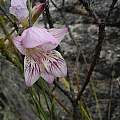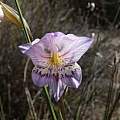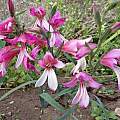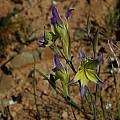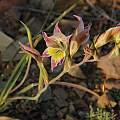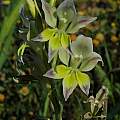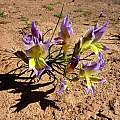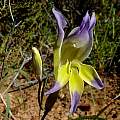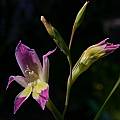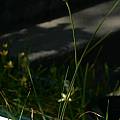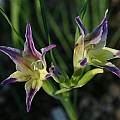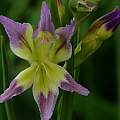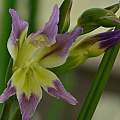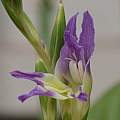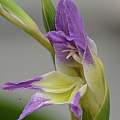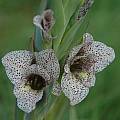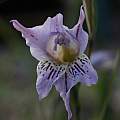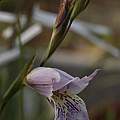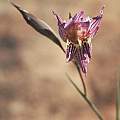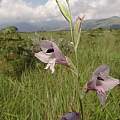Magenta to dark bluish purple is a another focus of Gladiolus diversity. Most of the Eurasian forms can be found here, but there are many South Africans as well.
Page 1: G. arcuatus... Page 2: G. imbricatus... Page 3: G. mutabilis...
Gladiolus scullyi Baker is found on silty clay and granite slopes in the northern winter rainfall areas (Namaqualand and western Karoo). It is very similar to Gladiolus venustus but is less colorful with dull yellow to light brown flowers with darker yellow on the lower tepals and darker brown to purplish highlights. The dorsal tepal is also more horizontal, inclined over the stamens and the upper two lateral tepals curve outward in an arc. It is fragrant and windowed in profile. Photos 1-2 taken by Bob Rutemoeller September 2006 near Nieuwoudtville (photos 1-2). Photos 3-5 taken by Cameron McMaster in various locations near Nieuwoudtville September 2011.
Photos 1-2 taken by Bob Rutemoeller September 2006 in Namaqualand. Photos 3-4 were taken by Cameron McMaster September 2011 near Carolusberg in Namaqualand. The last two photos were taken taken by Bob Werra.
Gladiolus stellatus G.J. Lewis is found on clay lower slopes in renosterveld in the coastal mountains of the Southern Cape (Swellendam to Port Elizabeth). It grows from 30 to 60 cm and has linear and whip-like leaves with a prominent midrib and small white to lilac star-like fragrant flowers. It flowers in spring (September to November). The first photo from the book Plants of the Klein Karoo courtesy of Jan and Anne Lise Schutte-Vlok. The second photo from Rod Saunders.
Gladiolus taubertianus Schltr. is restricted to the eastern Cederberg and the northern edge of the Cold Bokkeveld in the winter rainfall zone of the Western Cape where plants grow in coarse, stony, sandstone derived ground in well drained sites in dry mountain fynbos. Flowers are pale mauve to slate blue and lightly streaked with purple and lightly sweetly scented. The lower tepals have transverse yellow markings edged with dark purple. Flowering time is August to September. The first photo from Rachel Saunders taken in the Cederberg August 2012 and the second taken in the Northern Cape September 2015.
Gladiolus triphyllus Ker Gawl. , the smallest species of Eurasian Gladiolus, is endemic of the island of Cyprus, especially common on Akamas peninsula, but reported to be recently found in nearby Lebanon coasts too. It is winter growing, with 2-3 narrow leaves and a spike of up to 6 flowers in cultivation, but less in habitat.
Photo by Angelo Porcelli
Gladiolus venustus G.J.Lewis has flowers that are shades of purple to pink and sometimes dull yellow with yellow markings on the lower half of the lower tepals. It is widely distributed across the interior of the winter rainfall areas of southern Africa where it is found in dry habitats on clay and sandstone slopes. The primary pollinators are long tongued bees. It can be confused with Gladiolus scullyi and it has been included in that species at one time but it usually more colorful than that species which is usually greenish cream to yellow brown or beige and more highly scented. The dorsal tepal on Gladiolus scullyi is also more horizontal, inclined over the stamens and the upper two lateral tepals curve outward in an arc. But the distinctions are sometimes difficult to tell, especially in areas where they both grow. An example of this difficulty is shown in the third picture which I suppose could be either species. The first two photos by Mary Sue Ittner and Bob Rutemoeller were taken September 2006 in the Roggeveld. The third photo from Mary Sue Ittner was taken near Nieuwoudtville. The last two photos were taken by Cameron McMaster September 2011 near Middelpos in the Roggeveld.
Photos below were taken by Bob Werra.
Photos below were taken by Arnold Trachtenberg.
Gladiolus vinosomaculatus grows in exposed and often dry sites (rocky hilltops and slopes in short grassland) and on rocky outcrops in the summer rainfall areas of southern Africa north of the Vaal River. The tepals are covered with large purple to reddish spots on a pale background. The leaves have long sheaths that form a short pseudostem. This species is closely related to Gladiolus ecklonii. Photo taken by Rod Saunders.
Gladiolus violaceolineatus G.J.Lewis grows in the Cederberg Mountains, where it is generally found on south-facing sandstone slopes that remain moist throughout the winter, according to Goldblatt & Manning. The flower is pale violet with dark purple lines on the tepals, which are often narrower and longer than shown in these photos. The flowers are sweet-smelling, and reportedly bloom in early spring, although they may bloom a bit later at higher elevations. The first two photos by Michael Mace. The last photo from Rod Saunders.
Gladiolus woodii Baker grows in grassland, on rocky hillsides from 800 to 2000 m. in the summer rainfall area of South Africa from KwaZulu-Natal to the Limpopo Province. Mostly found in high elevation and high rainfall areas, it flowers early in the season, soon after it rains (from September to December). Leaves are often short and sheath the stem. Flowers are variable in color, pale yellow or lilac, oyster colored, dark maroon or red-brown with or without a longitudinal dark brown to purple stripe along the midline of the lower tepals and faintly to not scented. The upper tepals are much larger than the lower tepals and the lower laterals are folded. Photo from Rod Saunders.
Page 1: G. arcuatus... Page 2: G. imbricatus... Page 3: G. mutabilis...
